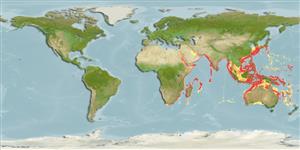Environment: milieu / climate zone / depth range / distribution range
Ökologie
seewasser benthopelagisch; tiefenbereich 2 - 1190 m (Ref. 40919). Tropical
Indo-West Pacific: Red Sea and False Bay, South Africa to Vanuatu, north to southern Japan, south to Australia.
Size / Gewicht / Alter
Maturity: Lm ? range ? - ? cm
Max length : 53.0 cm SL Männchen/unbestimmt; (Ref. 4404)
Rückenflossenstacheln (insgesamt): 13 - 14; Rückenflossenweichstrahlen (insgesamt): 105-119; Afterflossenstacheln 2; Afterflossenweichstrahlen: 107 - 119. Easily distinguished from other blennies by an extremely elongate body. Dorsal fin origin above eye.
Adults occur on open soft-bottom and mud habitats from shallow bays to deep water. They are found in tube-like burrows in sand or mud bottoms (Ref. 9710). Very rarely encountered but more usually seen at night (Ref. 90102). Nocturnal feeders. Stomach of two specimens trawled in 50-54 m off western India contain crustaceans (including copepods), polychaete remains, forams, fish scales, and some sand and mud (Ref. 11441). Oviparous. Eggs are demersal and adhesive (Ref. 205), and are attached to the substrate via a filamentous, adhesive pad or pedestal (Ref. 94114). Larvae are planktonic, often found in shallow, coastal waters (Ref. 94114). Have eel-like bodies but are rarely seen swimming away from their burrow (Ref. 48636).
Life cycle and mating behavior
Geschlechtsreife | Fortpflanzung | Ablaichen | Eier | Fecundity | Larven
Oviparous, distinct pairing (Ref. 205).
Randall, J.E., G.R. Allen and R.C. Steene, 1990. Fishes of the Great Barrier Reef and Coral Sea. University of Hawaii Press, Honolulu, Hawaii. 506 p. (Ref. 2334)
IUCN Rote Liste Status (Ref. 130435)
Bedrohung für Menschen
Harmless
Nutzung durch Menschen
Aquarium: Kommerziell
Mehr Information
ReferenzenAquakulturAquakultur ProfilZuchtlinienGenetikElectrophoresesVererbbarkeitKrankheitenVerarbeitungNutrientsMass conversion
PartnerBilderStamps, Coins Misc.LauteCiguateraGeschwindigkeitSchwimmstilKiemenoberflächeOtolithsGehirngrößeSehfähigkeit
Tools
Zusatzinformationen
Download XML
Internet Quellen
Estimates based on models
Preferred temperature (Ref.
123201): 8 - 19.8, mean 12.4 °C (based on 836 cells).
Phylogenetic diversity index (Ref.
82804): PD
50 = 0.7500 [Uniqueness, from 0.5 = low to 2.0 = high].
Bayesian length-weight: a=0.00102 (0.00046 - 0.00225), b=3.06 (2.88 - 3.24), in cm total length, based on all LWR estimates for this body shape (Ref.
93245).
Trophic level (Ref.
69278): 3.9 ±0.5 se; based on size and trophs of closest relatives
Widerstandsfähigkeit (Ref.
120179): mittel, Verdopplung der Population dauert 1,4 - 4,4 Jahre. (Assuming tm=1-3 and Fec=100-1000).
Fishing Vulnerability (Ref.
59153): Moderate to high vulnerability (46 of 100).
